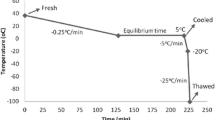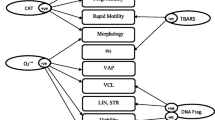Abstract
Purpose
The aim of this study was to evaluate the conventional sperm parameters, level of intracellular reactive oxygen species (ROS), DNA fragmentation (DF) and dysfunction of mitochondrial membrane potential (MMP) after semen preparation techniques with flow cytometry.
Methods
Semen samples were obtained from 28 men with normal semen analysis according to WHO (world health organization). Each was divided into three equal parts for processing with routine techniques: conventional swim up (CSW), direct swim up (DSW) and density gradient centrifugation (DGC). The conventional sperm parameters were evaluated with computer-assisted sperm analyzer (CASA) and the level of intracellular ROS, dysfunction of MMP and DF were determined with flow cytometry procedure.
Results
Conventional sperm parameters such as motility, progressive motility and normal morphology increased after sperm processing by CSW and DGC compared to DSW. A significant increase in intracellular H2O2 (p < 0.05) was demonstrated in the CSW versus DSW technique, while processed sperm by the DSW procedure showed a significant increase in the percentage of dysfunction of MMP and intracellular O •−2 (p < 0.05) when compared with CSW and DGC techniques. Additionally, a high mean of DF (p < 0.05) was observed in the DGC technique as compared to CSW.
Conclusion
Data from flow cytometry study demonstrated that intracellular H2O2 and DF increased after CSW and DGC processing techniques, respectively, whereas the level of intracellular O •−2 and dysfunction of MMP only increased after the DSW processing technique.


Similar content being viewed by others
References
de Lamirande E, OFlaherty C (2008) Sperm activation: role of reactive oxygen species and kinases. Biochimica et Biophysica Acta (BBA). Proteins Proteomics 1784(1):106–115
Agarwal A, Said TM, Bedaiwy MA, Banerjee J, Alvarez JG (2006) Oxidative stress in an assisted reproductive techniques setting. Fertil Steril 86(3):503–512. doi:10.1016/j.fertnstert.2006.02.088
Henkel R, Schill W-B (2003) Sperm preparation for ART. Reprod Biol Endocrinol 1(1):108
Saleh RA, Agarwal A (2002) Oxidative stress and male infertility: from research bench to clinical practice. J Androl 23(6):737–752
Khajavi N, Rs MM, Marzieh Tavalaei, Deymeh MR, Hossein Nasresfahani Mohammad (2009) Can Zeta sperm selection method recover sperm with higher DNA integrity compare to density gradient centrifugation? Iran J Reprod Med 7(2):73–77
Li Z, Zhou Y, Liu R, Lin H, Liu W, Xiao W, Lin Q (2011) Effects of semen processing on the generation of reactive oxygen species and mitochondrial membrane potential of human spermatozoa. Andrologia. doi:10.1111/j.1439-0272.2010.01123.x
O’Connell M, McClure N, Powell LA, Steele EK, Lewis SE (2003) Differences in mitochondrial and nuclear DNA status of high-density and low-density sperm fractions after density centrifugation preparation. Fertil Steril 79(Suppl 1):754–762 (pii: S0015028202048276)
Aitken RJ, Clarkson JS (1988) Significance of reactive oxygen species and antioxidants in defining the efficacy of sperm preparation techniques. J Androl 9(6):367–376
Wang X, Sharma RK, Gupta A, George V, Thomas AJ, Falcone T, Agarwal A (2003) Alterations in mitochondria membrane potential and oxidative stress in infertile men: a prospective observational study. Fertil Steril 80:844–850
Saleh RA, Agarwal A, Nada EA, El-Tonsy MH, Sharma RK, Meyer A, Nelson DR, Thomas AJ (2003) Negative effects of increased sperm DNA damage in relation to seminal oxidative stress in men with idiopathic and male factor infertility. Fertil Steril 79:1597–1605
Sakkas D, Manicardi GC, Tomlinson M, Mandrioli M, Bizzaro D, Bianchi PG, Bianchi U (2000) The use of two density gradient centrifugation techniques and the swim-up method to separate spermatozoa with chromatin and nuclear DNA anomalies. Hum Reprod 15(5):1112–1116. doi:10.1093/humrep/15.5.1112
Lachaud C, Tesarik J, Caà ± adas ML, Mendoza C (2004) Apoptosis and necrosis in human ejaculated spermatozoa. Hum Reprod 19(3):607–610. doi:10.1093/humrep/deh130
Guthrie HD, Welch GR (2006) Determination of intracellular reactive oxygen species and high mitochondrial membrane potential in Percoll-treated viable boar sperm using fluorescence-activated flow cytometry. J Anim Sci 84(8):2089–2100. doi:10.2527/jas.2005-766
Larsen L, Scheike T, Jensen TK, Bonde JP, Ernst E, Hjollund NH, Zhou Y, Skakkebæk NE, Giwercman A, The Danish First Pregnancy Planner Study Team (2000) Computer-assisted semen analysis parameters as predictors for fertility of men from the general population. Hum Reprod 15(7):1562–1567. doi:10.1093/humrep/15.7.1562
Gil-Guzman E, Ollero M, Lopez MC, Sharma RK, Alvarez JG, Thomas AJ, Agarwal A (2001) Differential production of reactive oxygen species by subsets of human spermatozoa at different stages of maturation. Hum Reprod 16(9):1922–1930. doi:10.1093/humrep/16.9.1922
Mahfouz RZ, du Plessis SS, Aziz N, Sharma R, Sabanegh E, Agarwal A (2010) Sperm viability, apoptosis, and intracellular reactive oxygen species levels in human spermatozoa before and after induction of oxidative stress. Fertil Steril 93(3):814–821. doi:10.1016/j.fertnstert.2008.10.068
Mahfouz R, Sharma R, Lackner J, Aziz N, Agarwal A (2009) Evaluation of chemiluminescence and flow cytometry as tools in assessing production of hydrogen peroxide and superoxide anion in human spermatozoa. Fertil Steril 92(2):819–827
Espinoza JA, Schulz MA, Sánchez R, Villegas JV (2009) Integrity of mitochondrial membrane potential reflects human sperm quality. Andrologia 41(1):51–54. doi:10.1111/j.1439-0272.2008.00878.x
Yang Y, Monserud RA, Huang S (2004) An evaluation of diagnostic tests and their roles in validating forest biometric models. Can J For Res 34(3):619–629
Saleh RA, Agarwal A (2002) Oxidative stress and male infertility: from research bench to clinical practice. J Androl 23(6):737–752
Jameel T (2008) Sperm swim-up: a simple and effective technique of semen processing for intrauterine insemination. J Pak Med Assoc 58(2):71–74
Mortimer D (2000) Sperm preparation methods. J Androl 21(3):357–366
Henkel R, Franken D, Lombard C, Schill W-B (1994) Selective capacity of glass-wool filtration for the separation of human spermatozoa with condensed chromatin: a possible therapeutic modality for male-factor cases? J Assist Reprod Genet 11(8):395–400. doi:10.1007/bf02211725
Guthrie HD, Welch GR (2012) Effects of reactive oxygen species on sperm function. Theriogenology. doi:10.1016/j.theriogenology.2012.05.002
Le Lannou D, Blanchard Y (1988) Nuclear maturity and morphology of human spermatozoa selected by Percoll density gradient centrifugation or swim-up procedure. J Reprod Fertil 84(2):551–556. doi:10.1530/jrf.0.0840551
Moohan JM, Lindsay KS (1995) Spermatozoa selected by a discontinuous Percoll density gradient exhibit better motion characteristics, more hyperactivation, and longer survival than direct swim-up. Fertil Steril 64(1):160–165
Yamamoto Y, Maenosono S, Okada H, Miyagawa I, Sofikitis N (1997) Comparisons of sperm quality, morphometry and function among human sperm populations recovered via SpermPrep II filtration, swim-up and Percoll density gradient methods. Andrologia 29(6):303–310
Mortimer D (1990) Semen analysis and sperm washing techniques. In: Gagnon C (ed) Control of sperm motility: biological clinical aspects. CRC Press, Boca Raton, F1; 1990:263–284
Mortimer S (1997) A critical review of the physiological importance and analysis of sperm movement in mammals. Hum Reprod Update 3(5):403–439. doi:10.1093/humupd/3.5.403
Mortimer D, Leslie EE, Kelly RW, Templeton AA (1982) Morphological selection of human spermatozoa in vivo and in vitro. J Reprod Fertil 64(2):391–399. doi:10.1530/jrf.0.0640391
McGovern P, Quagliarello J, Arny M (1989) Relationship of within-patient semen variability to outcome of intrauterine insemination. Fertil Steril 51(6):1019–1023
Marchetti C, Obert G, Deffosez A, Formstecher P, Marchetti P (2002) Study of mitochondrial membrane potential, reactive oxygen species, DNA fragmentation and cell viability by flow cytometry in human sperm. Hum Reprod 17(5):1257–1265
Soderlund B, Lundin K (2000) The use of silane-coated silica particles for density gradient centrifugation in in vitro fertilization. Hum Reprod 15(4):857–860. doi:10.1093/humrep/15.4.857
Ren SS, Sun GH, Ku CH, Chen DC, Wu GJ (2004) Comparison of four methods for sperm preparation for IUI. Arch Androl 50(3):139–143. doi:10.1080/01485010490425566
Pranav P, Lucy L, Zuying C, Thomas T, Raja S, Isaac S, Keith I (1998) Preparation by differential gradient centrifugation is better than swim-up in selecting sperm with normal morphology (strict criteria). Fertil Steril 69(4):722–726
Nisarg D, Rakesh S, Kartikeya M, Edmund S, Ashok A (2009) Physiologic and pathologic levels of reactive oxygen species in neat semen of infertile men. Fertil Steril 92(5):1626–1631
Andolz P, Bielsa MA, Genesca A, Benet J, Egozcue J (1987) Improvement of sperm quality in abnormal semen samples using a modified swim-up procedure. Hum Reprod 2(2):99–101
Barroso G, Taylor S, Morshedi M, Fl Manzur, Gavino F, Oehninger S (2006) Mitochondrial membrane potential integrity and plasma membrane translocation of phosphatidylserine as early apoptotic markers: a comparison of two different sperm subpopulations. Fertil Steril 85(1):149–154
Espinoza JA, Paasch U, Villegas JV (2009) Mitochondrial membrane potential disruption pattern in human sperm. Hum Reprod 24(9):2079–2085. doi:10.1093/humrep/dep120
Zini A, Finelli A, Phang D, Jarvi K (2000) Influence of semen processing technique on human sperm DNA integrity. Urology 56(6):1081–1084 (pii: S0090-4295(00)00770-6)
Santiso R, Tamayo M, Gosalvez J, Meseguer M, Garrido N, Fernandez JL (2010) Swim-up procedure selects spermatozoa with longer telomere length. Mutat Res 688(1–2):88–90. doi:10.1016/j.mrfmmm.2010.03.003
Irvine DS, Twigg JP, Gordon EL, Fulton N, Milne PA, Aitken RJ (2000) DNA integrity in human spermatozoa: relationships with semen quality. J Androl 21(1):33–44
Sakkas D, Mariethoz E, Manicardi G, Bizzaro D, Bianchi P, Bianchi U (1999) Origin of DNA damage in ejaculated human spermatozoa. Rev Reprod 4(1):31–37. doi:10.1530/ror.0.0040031
Zhang XD, Chen MY, Gao Y, Han W, Liu DY, Huang GN (2011) The effects of different sperm preparation methods and incubation time on the sperm DNA fragmentation. Hum Fertil (Camb) 14(3):187–191. doi:10.3109/14647273.2011.604817
Sun JG, Jurisicova A, Casper RF (1997) Detection of deoxyribonucleic acid fragmentation in human sperm: correlation with fertilization in vitro. Biol Reprod 56(3):602–607. doi:10.1095/biolreprod56.3.602
Oosterhuis GJE, Andre BM, Ellen K-B, Cornelis BL, Joop S, Istvan V (2000) Measuring apoptosis in human spermatozoa: a biological assay for semen quality? Fertil Steril 74(2):245–250
Aitken RJ, Gordon E, Harkiss D, Twigg JP, Milne P, Jennings Z, Irvine DS (1998) Relative impact of oxidative stress on the functional competence and genomic integrity of human spermatozoa. Biol Reprod 59(5):1037–1046. doi:10.1095/biolreprod59.5.1037
Younglai EV, Holt D, Brown P, Jurisicova A, Casper RF (2001) Sperm swim-up techniques and DNA fragmentation. Hum Reprod 16(9):1950–1953. doi:10.1093/humrep/16.9.1950
Acknowledgments
The authors thank Dr. Bita Ebrahimi and Mr Fazel Samani for their assistance and helpful comments during this project.
Conflict of interest
None.
Author information
Authors and Affiliations
Corresponding author
Rights and permissions
About this article
Cite this article
Ghaleno, L.R., Valojerdi, M.R., Janzamin, E. et al. Evaluation of conventional semen parameters, intracellular reactive oxygen species, DNA fragmentation and dysfunction of mitochondrial membrane potential after semen preparation techniques: a flow cytometric study. Arch Gynecol Obstet 289, 173–180 (2014). https://doi.org/10.1007/s00404-013-2946-1
Received:
Accepted:
Published:
Issue Date:
DOI: https://doi.org/10.1007/s00404-013-2946-1




